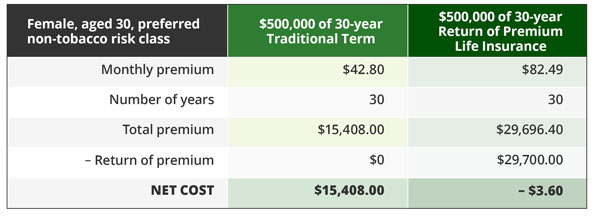You may be surprised to learn that some life insurance policies will pay you back while you’re living.
For many, life insurance is a way to make sure their family would be OK financially if something were to happen to them, and they are willing to pay the premium amount to have that safety net in place. There are several types of policies but one that isn’t talked about very often is called return of premium life insurance. With this type of coverage, which has a higher premium cost than term life insurance, you can get your premiums* returned to you if the policy period ends and the insured person is still living.
What is return of premium life insurance?
Like traditional term life insurance, return of premium life insurance lasts a certain length of time and then the coverage ends. (This is different from permanent life insurance plans - like whole life and universal life - which provide lifelong coverage. Contact us at Brown Insurance Group to learn about the pros and cons of term vs. permanent life insurance to determine what’s best for you.)
Unlike traditional term life insurance, return of premium life insurance builds cash value during the policy period. And, if the insured person is still living when the policy period is up, the owner of the policy can get the premiums* paid returned to them.
Here’s another way to look at it:
Traditional term life insurance is pure protection. It works like auto insurance where you pay regular premiums so that the insurance company will pay to fix your car in case you have an accident covered by your policy. If an accident happens, the company pays the claim. If you never have an accident, you probably wouldn’t receive any money back from the insurance company. Term life insurance works the same way. If the insured person outlives the policy, the owner probably won’t get any money back from the company. With both types of insurance, the insurance customer pays simply to have protection for that period of time.
Return of premium life insurance is different. It still pays the death benefit if the insured person dies during the policy period. However, if that person survives the policy period (the most likely outcome), the insurer will pay back 100% of eligible premiums* -- so the net cost can be $0.
How does return of premium life insurance work?
Let’s look at a hypothetical example. Sara, a 30-year-old female, is interested in comparing traditional term life insurance to return of premium life insurance.
In the chart below, you can see how much Sara pays for her 30-year policy. Her monthly payments for a return of premium life insurance policy are higher than a traditional term life insurance policy; however, her net cost at the end of the policy period – if she’s still living – is less than $0. In this case, the company would return all her premiums plus $3.60. Whereas, she would have a net cost of $15,408 at the end of a traditional term policy.

*Premiums paid for rider benefits and substandard ratings are not included in the return of premium calculation.
Advantages and disadvantages of return of premium life insurance
Here are some advantages to choosing return of premium life insurance:
- Your premiums can be returned when the policy period is up, which can bring down the net cost of the policy to $0.
- The lump sum can be used to help cover college expenses, supplement retirement income or pay off a remaining mortgage balance, for example.
- You may be able to borrow from the policy’s cash value, if needed.
- If you cancel the policy during the policy period, you can get the cash value returned to you.
Here are some disadvantages to choosing return of premium life insurance:
- Because return of premium policies will make a pay-out regardless of what happens to the insured person, these policies are more expensive than traditional term policies.
- If you were to buy a traditional term policy and invest the difference, you might end up with more money at the end of the policy period.
The bottom line is that it may be worthwhile to take a closer look at return of premium life insurance when considering a term life insurance policy.
For specific coverage details, always refer to your policy. If the policy coverage descriptions in this article conflict with the language in the policy, the language in the policy applies.
Content obtained with permission from the original author, Grange Insurance.

